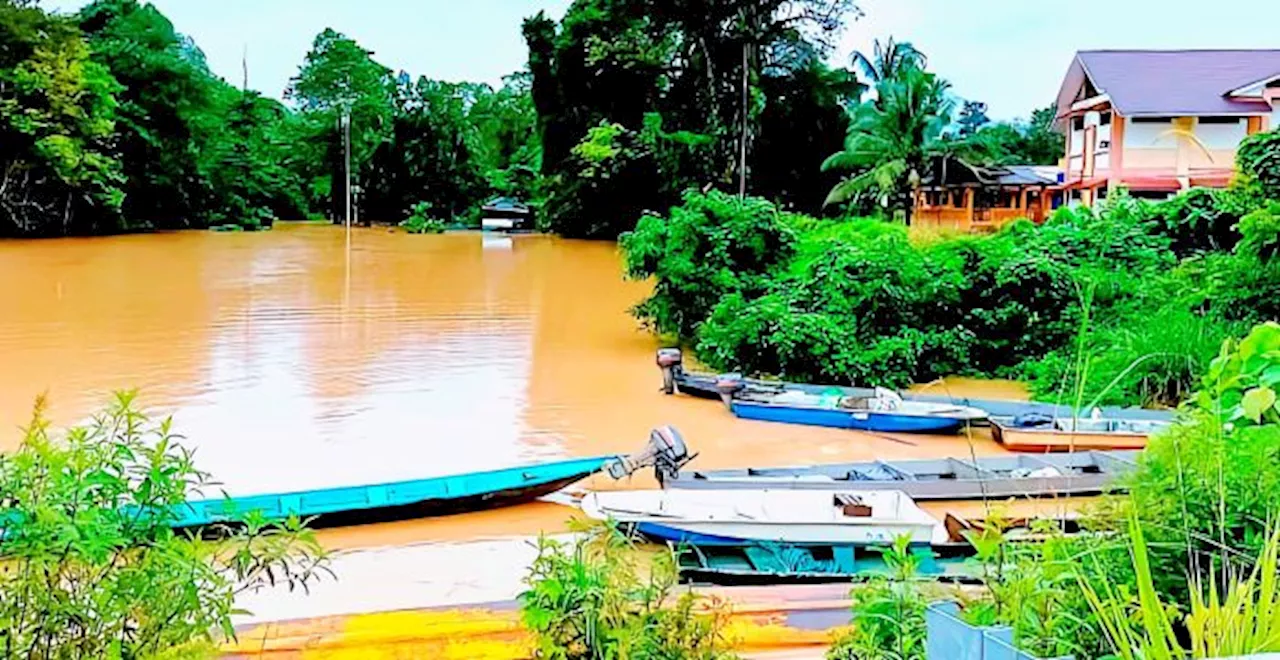Villages on the banks of Sungai Tembeling in Ulu Tembeling, Malaysia, are facing the imminent threat of disappearing due to recurring floods. The flooding is attributed to deforestation driven by commercial interests, leading to soil erosion and ecosystem disruption. Residents fear for their homes, livelihoods, and cultural heritage. The text explores the impact of climate change, deforestation, and unsustainable development on these communities.
Six Malay villages on the banks of Sungai Tembeling in Ulu Tembeling are facing the threat of disappearing within two decades due to recurring floods. Approximately 4,000 residents in Kampung Gusai, Kampung Bantal, Kampung Seberang Bantal, Kampung Kuala Sat, Kampung Pagi, and Kampung Kuala Tahan live in constant fear of their homes being submerged, especially during heavy rainfall and the Northeast Monsoon season. During the 2014 flood, entire settlements along Sungai Tembeling were inundated.
Even now, floods threaten riverside communities with overflow and strong currents that sweep away debris, damaging public facilities and posing a significant risk to their safety. This situation jeopardizes the long-term sustainability of these settlements, primarily affecting the well-being and security of the inhabitants. Mustapha Abdullah, a resident of Kampung Pagi, expressed that if floods continue to worsen and become more frequent, residents of Sungai Tembeling's banks may have to gradually relocate, either establishing new settlements away from the river or seeking alternative living arrangements. He further highlighted that the current settlements along Sungai Tembeling and its tributaries are crucial for their livelihoods, providing income through fishing, aquaculture, and tourism. The disappearance of these villages would mean the loss of the Ulu Tembeling Malay community's unique cultural heritage, estimated to be 600 years old. It would also erase the historical significance of the area, which was a meeting point for traders from Sumatra, Java, China, and Siam who traveled along Sungai Pahang and Sungai Tembeling. The legacy of British colonial rule would also be diminished, as the area was initially designated as Taman Negara King George in 1938/1939 before becoming the renowned Taman Negara. Mustapha pointed out that deforestation for development and timber extraction, especially in the last 20 years, is a major contributing factor to the frequent flooding along Sungai Tembeling. He believes that this has disrupted the ecosystem, leading to soil erosion and compromising the sustainability of the environment. He criticized projects that aim to transform the landscape of Ulu Tembeling into new developments with basic infrastructure, arguing that these projects exploit the forests while causing harm to the local population. Villagers like Jamizan Rashid, 46, and Zulkefli Ahmad, 61, share his concerns. They observe that even short bursts of heavy rain in the upper reaches lead to sudden surges in Sungai Tembeling's water levels, causing flash floods. They have witnessed the accumulation of silt after floods, leading to a gradual shallowing of the river. Zulkefli welcomes development but emphasizes the need for meticulous planning that protects the environment and its biodiversity. He notes that habitat loss has forced wildlife like elephants, tigers, tapirs, and other species to venture into villages in search of food. He also observes a decline in fish populations, particularly kelah, patin, lawang, and kenerak, due to the changing river dynamics. Zamri Mat Ami, 57, from Tembeling Tengah, shares the villagers' fear that the riverside settlements in Ulu Tembeling might vanish within two decades. He blames extensive deforestation driven by commercial interests over the past 20 years for the recurring floods. He feels the damage caused by deforestation is irreversible and believes that the unique cultural values of the Malay community, deeply rooted in local flora and fauna-based cuisine, are at risk. He worries that in 20 years, traditional plants and fish species like the paku, ulaman, kelah, patin, lawang, and kenerak may become increasingly scarce due to erosion and environmental degradation. He points to the efforts of Tengku Mahkota Pahang, Tengku Hassanal Ibrahim Alam Shah, in establishing Gunung Aais Forest Reserve in Ulu Tembeling as a haven for the Malayan Tiger as a positive step towards preserving the forest in the region
Climate Change Deforestation Flooding Malaysia Sungai Tembeling Ulu Tembeling Sustainability Environmental Impact
Malaysia Latest News, Malaysia Headlines
Similar News:You can also read news stories similar to this one that we have collected from other news sources.
 Jelai River Flood Mitigation Project to Begin in AprilConstruction for the Sungai Jelai Flood Mitigation Project (RTB) is expected to begin in April next year. The RM164 million project has already begun in February with the preparation of appropriate designs. It spans nearly 40 kilometers, covering the Sungai Jelai from Inas to the junction of Sungai Muar and Sungai Johol. The project entails the construction of flood control structures and drainage systems to reduce the impact of flooding.
Jelai River Flood Mitigation Project to Begin in AprilConstruction for the Sungai Jelai Flood Mitigation Project (RTB) is expected to begin in April next year. The RM164 million project has already begun in February with the preparation of appropriate designs. It spans nearly 40 kilometers, covering the Sungai Jelai from Inas to the junction of Sungai Muar and Sungai Johol. The project entails the construction of flood control structures and drainage systems to reduce the impact of flooding.
Read more »
 Flooding in Three Surat Thani Villages After Heavy Rain and High TidesAt least three seaside villages in Surat Thani were flooded on Sunday (Jan 12) morning following heavy rain and a rising sea tide accompanied by three-to-four-metre-high waves. The seaside areas in Don Sak, Kanchanadit, and Tha Chana districts of Surat Thani were hit by heavy rain around 9:30am.
Flooding in Three Surat Thani Villages After Heavy Rain and High TidesAt least three seaside villages in Surat Thani were flooded on Sunday (Jan 12) morning following heavy rain and a rising sea tide accompanied by three-to-four-metre-high waves. The seaside areas in Don Sak, Kanchanadit, and Tha Chana districts of Surat Thani were hit by heavy rain around 9:30am.
Read more »
 Early morning storm wreaks havoc on water villages in Semporna, damages 30 homesKUALA LUMPUR, Dec 22 — At least 30 houses in two water villages here were damaged by a storm and strong winds early this morning. Semporna Fire and Rescue Station Chief, Madzlan...
Early morning storm wreaks havoc on water villages in Semporna, damages 30 homesKUALA LUMPUR, Dec 22 — At least 30 houses in two water villages here were damaged by a storm and strong winds early this morning. Semporna Fire and Rescue Station Chief, Madzlan...
Read more »
 Storm Devastates Water Villages in Semporna, Leaving 497 DisplacedA powerful storm ravaged four water villages in Semporna, Sabah, Malaysia, causing widespread damage to homes and displacing hundreds of residents. The storm struck early Sunday morning, resulting in the collapse of 11 houses and damage to 102 others.
Storm Devastates Water Villages in Semporna, Leaving 497 DisplacedA powerful storm ravaged four water villages in Semporna, Sabah, Malaysia, causing widespread damage to homes and displacing hundreds of residents. The storm struck early Sunday morning, resulting in the collapse of 11 houses and damage to 102 others.
Read more »
 200-Year-Old Villages in Nakawan Range Attract Attention as New Tourism HotspotThe existence of villages over 200 years old along the Nakawan Range, overlooking Bukit Wang Gunung, has attracted attention. The 36-kilometer Nakawan Range, from Bukit Batu Putih in Kuala Perlis to Wang Kelian, the longest limestone range in Malaysia, has the potential to become a new tourism destination. Officials recently explored the range to a village in Wang Angin, over 200 years old. They see potential for tourism, agriculture, and sports development due to existing trails suitable for running. Plans are underway to develop new attractions and maintain the natural environment.
200-Year-Old Villages in Nakawan Range Attract Attention as New Tourism HotspotThe existence of villages over 200 years old along the Nakawan Range, overlooking Bukit Wang Gunung, has attracted attention. The 36-kilometer Nakawan Range, from Bukit Batu Putih in Kuala Perlis to Wang Kelian, the longest limestone range in Malaysia, has the potential to become a new tourism destination. Officials recently explored the range to a village in Wang Angin, over 200 years old. They see potential for tourism, agriculture, and sports development due to existing trails suitable for running. Plans are underway to develop new attractions and maintain the natural environment.
Read more »
 Floods Hit Several Villages in Kelantan, MalaysiaHeavy rain overnight caused floods in several villages in the Kuala Krai and Tanah Merah districts of Kelantan, Malaysia. Water levels rose, disrupting road access and prompting the activation of temporary relief centers.
Floods Hit Several Villages in Kelantan, MalaysiaHeavy rain overnight caused floods in several villages in the Kuala Krai and Tanah Merah districts of Kelantan, Malaysia. Water levels rose, disrupting road access and prompting the activation of temporary relief centers.
Read more »
